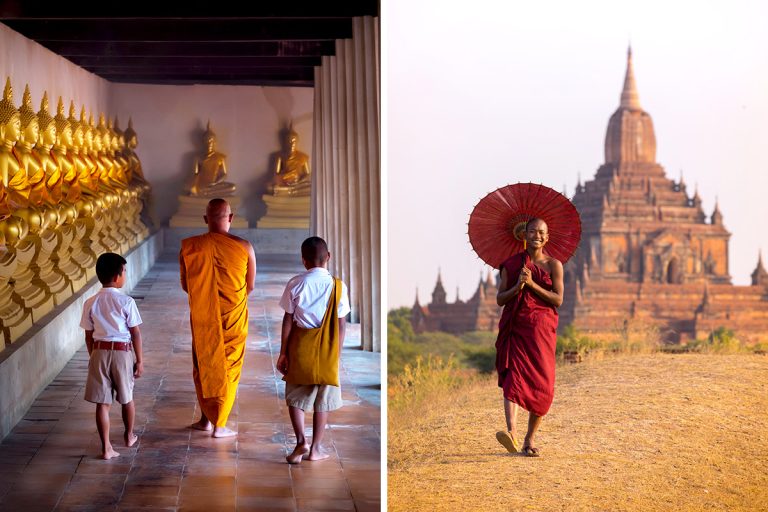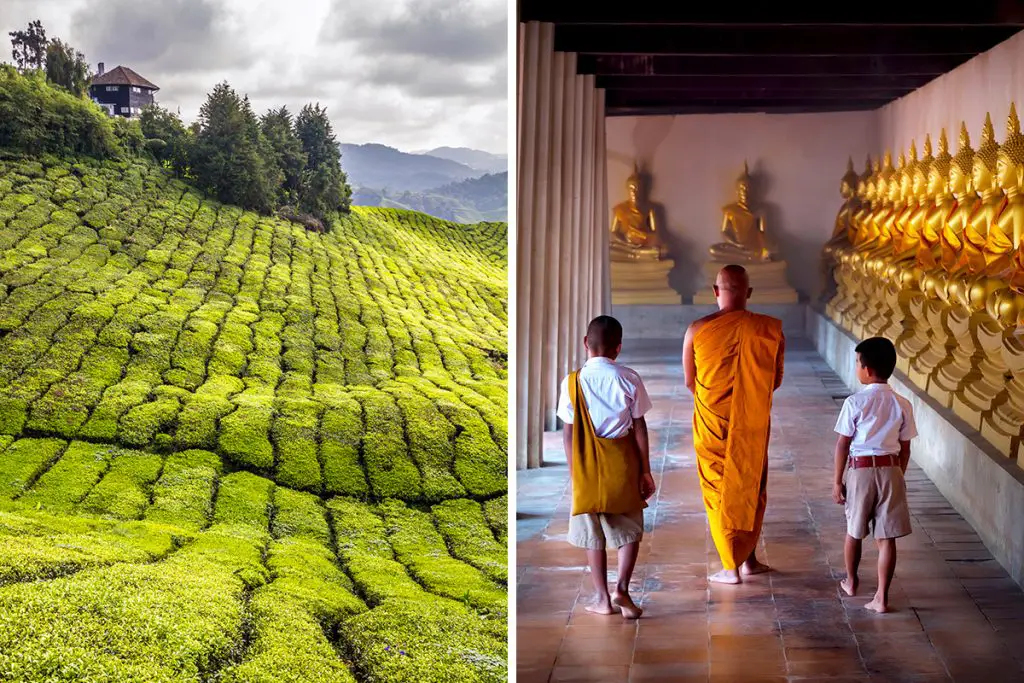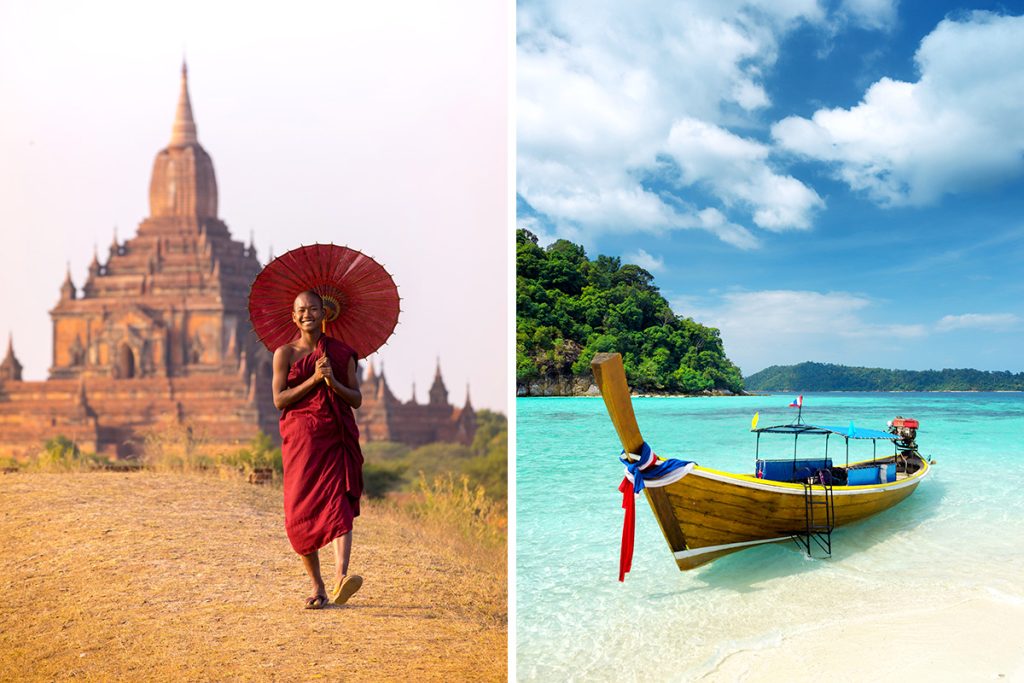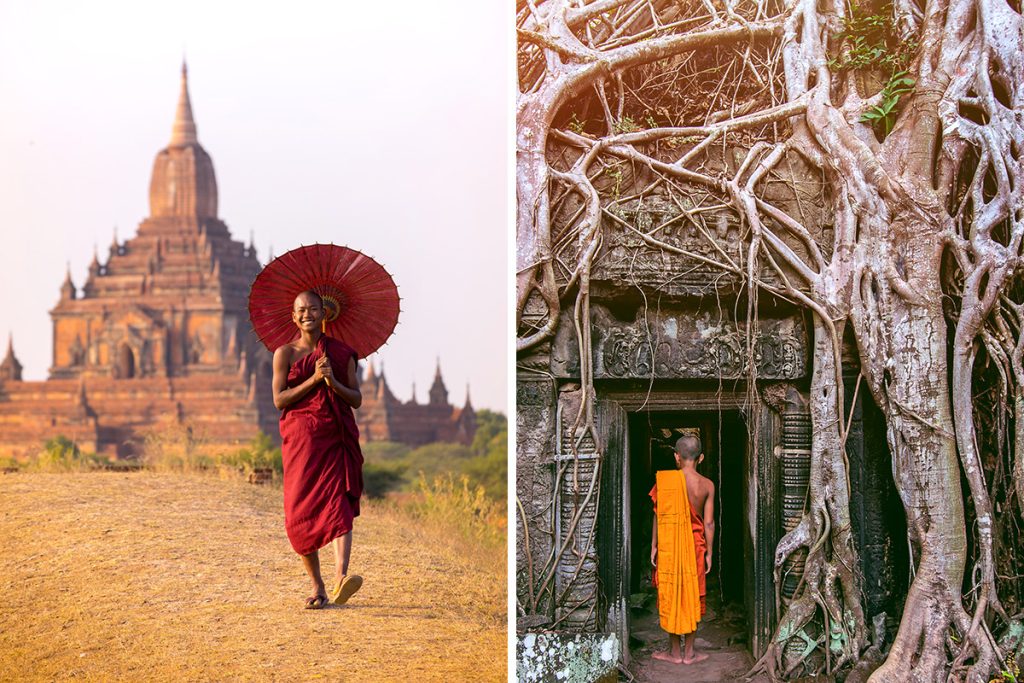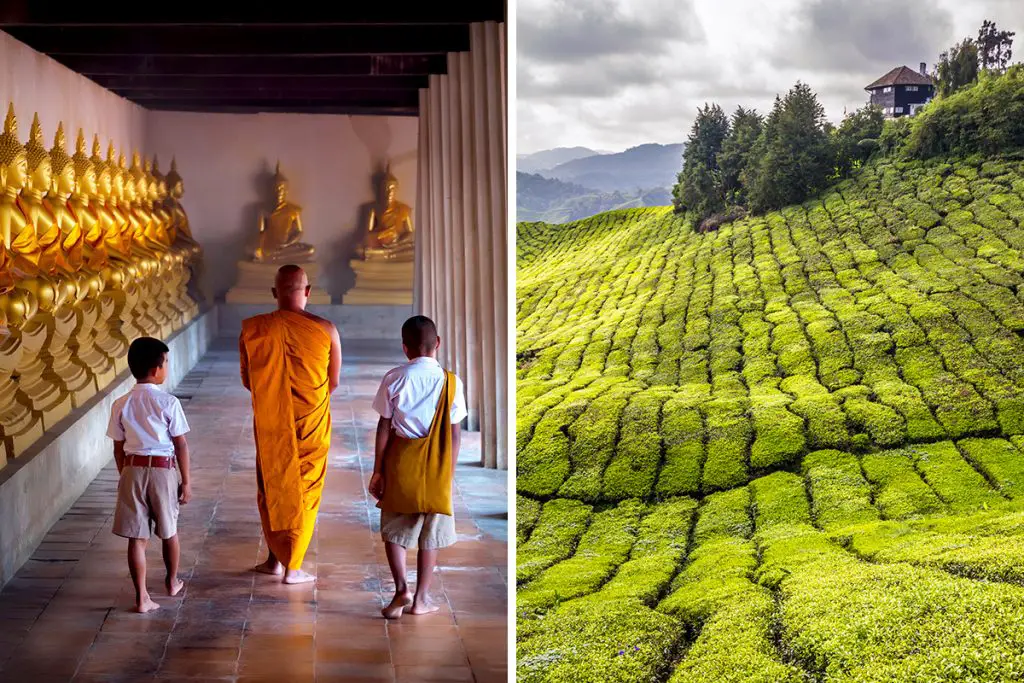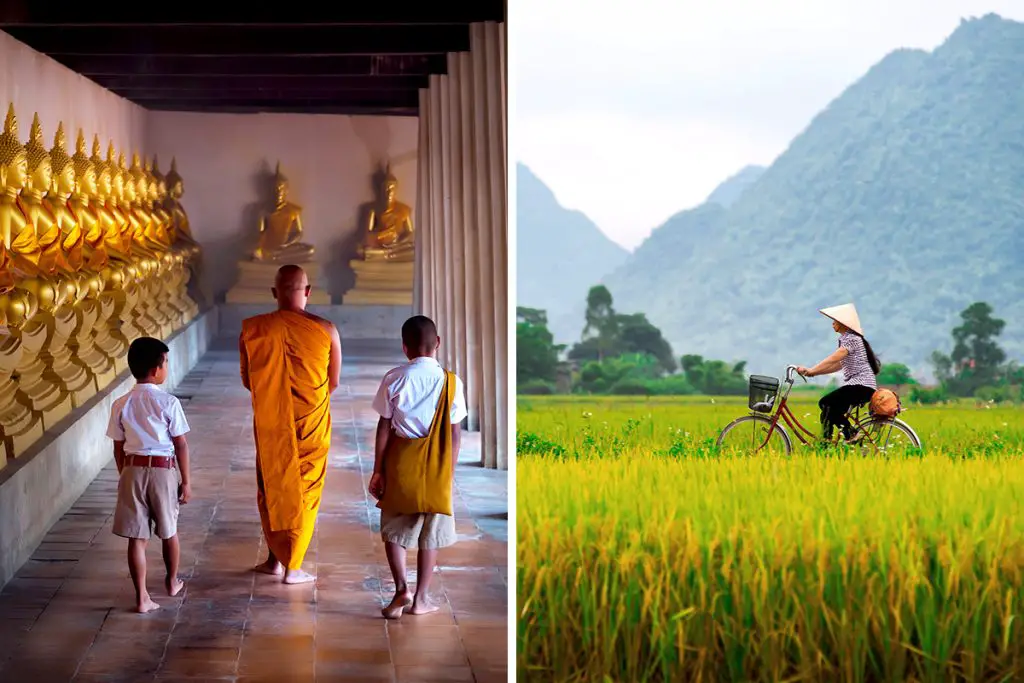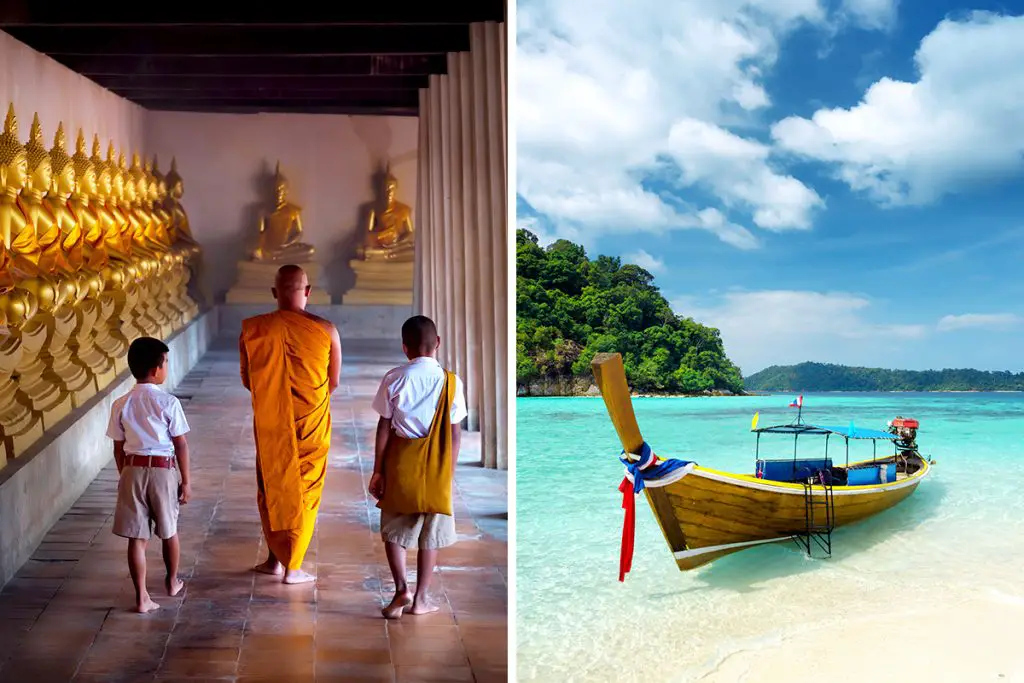Delving into the past and embracing the present-day cultures of these countries is no small feat. You might be captivated by Laos’s Buddhist traditions or Myanmar’s diverse ethnic groups. But how do these two compare on a deeper level? Stick around, you’re about to find out.
History & Culture
You’re probably eager to know how the histories and cultures of Laos and Myanmar differ, so let’s dive in. Both nations have fascinating backgrounds that help shape their modern-day identities, but they have distinct elements that make each a unique destination.
Laos is deeply influenced by Theravada Buddhism, which you can feel in its calm, laid-back atmosphere.
The country has been a center for spiritual learning and offers a profound sense of tranquility. It’s a place where monks roam the streets during the early morning alms ceremony, and ancient Buddhist temples stand tall against the sky. The culture here is a harmonious blend of indigenous beliefs and Buddhism.
On the other hand, Myanmar is a complex tapestry of over 135 ethnic groups. Although the majority practice Buddhism, you’ll also find influences of Christianity, Hinduism, and Islam.
The variety of cultures converge in festivals, languages, and customs that are uniquely Burmese. For instance, you might witness the spectacular Thingyan Water Festival or hear the diverse dialects that echo through the country’s bustling markets.
Both nations have a rich history of kingdoms and empires, each contributing to their national identities. In Laos, the Lan Xang kingdom was once a regional power, while Myanmar had its own storied history as the Pagan and Konbaung kingdoms. These past empires left a lasting impact, shaping the architecture, religious practices, and even the political landscape.
Laos and Myanmar are not just two countries on a map; they are living museums of their respective histories and traditions. In summary, Laos leans more towards spiritual tranquility influenced by Buddhism, while Myanmar offers a complex mix of cultures and beliefs. Whichever you choose, you’re in for a rich, historical adventure that you won’t soon forget.
Attractions & Activities
Wondering how to fill your days while visiting Laos and Myanmar? Both countries offer an abundance of attractions and activities that speak to the adventurer, historian, and nature lover in you. Let’s explore what makes each destination a treasure trove of experiences.
In Laos, the city of Luang Prabang serves as a focal point for history buffs and nature enthusiasts.
The Royal Palace Museum gives you a glimpse into the country’s past, while the Kuang Si Falls, about 29 kilometers (about 18 miles) away from the city, offers a stunning natural retreat. Don’t miss the chance to venture out into the Bolaven Plateau, where you can marvel at coffee plantations and more cascading waterfalls.
Myanmar is also no slouch when it comes to attractions. In Bagan, you can take a hot-air balloon ride over a sprawling area filled with over 2,000 pagodas and temples. If you’re more of an outdoor person, a trek through the hills of Shan State will take you through traditional villages and offer jaw-dropping views of the landscape.
The Mahamuni Buddha Temple in Mandalay, on the other hand, holds one of the most revered Buddha images in the country.
Though both countries are steeped in history, they offer different ways to engage with it. While Laos pulls you into its natural wonders and quiet historical sites, Myanmar offers a more varied range of activities, from temple-hopping to trekking in mountainous terrains.
Beaches
Craving the sun, sand, and sea? Laos and Myanmar offer different coastal experiences to satisfy your beachside wanderlust. Here’s how they stack up against each other.
It’s important to note that Laos is landlocked, so if you’re seeking a beach holiday, this may not be your first choice. You can, however, find some riverside spots like the banks of the Mekong River for a more laid-back, albeit different, kind of water experience.
Myanmar offers a coastline stretching around 1,930 kilometers (about 1,200 miles), graced with a variety of beaches. Ngapali Beach, for instance, is known for its palm-fringed landscapes and the clear blue waters of the Bay of Bengal.
Another option could be Ngwe Saung Beach, about 48 kilometers (around 30 miles) long, where you can enjoy water sports like snorkeling and diving.
To wrap it up, if a beach vacation is a must for you, Myanmar is the better choice with its long, scenic coastline. However, Laos offers its own version of waterfront relaxation along the banks of its iconic rivers.
Eating, Drinking & Nightlife
Food and fun after dark—these are essential parts of any trip, right? Laos and Myanmar have their own unique flavors and vibes when it comes to eating, drinking, and nightlife. Let’s dig in to see how they compare.
In Laos, you’ll often find simple yet delicious dishes, like “larb,” a type of meat salad, and “khao niew,” sticky rice. Meals are generally more laid-back affairs, often enjoyed in the comfort of someone’s home or in small, family-owned eateries.
Myanmar offers a rich culinary landscape with influences from China, India, and Thailand. You might try “mohinga,” a fish soup that’s considered the national dish, or “laphet,” a tea leaf salad. Restaurants range from traditional Burmese eateries to more cosmopolitan options.
When it comes to drinks, Laos is famous for its Beerlao, a rice-based lager that’s a staple at almost every social gathering. Sipping on this local brew while watching the sunset over the Mekong River is a popular pastime.
In Myanmar, tea is more than just a drink; it’s a social activity. Tea houses serve as communal spaces where people gather for a cup of strong, sweet Burmese tea. You’ll also find local beers like Myanmar Lager and Mandalay Lager in most restaurants.
Nightlife in Laos is quieter compared to other Southeast Asian countries. Vientiane, the capital, has a few low-key bars and night markets where you can enjoy a peaceful evening. Myanmar’s nightlife is a bit more dynamic, especially in cities like Yangon and Mandalay, where you can find an array of bars and clubs.
To sum up, Laos offers a more subdued dining and nightlife experience, perfect for those looking to unwind and take it easy. Myanmar provides a wider range of food options and a more vibrant nightlife, ideal for those seeking more variety and excitement.
Shopping
Who doesn’t love a good shopping spree, especially when you’re in a new place? Laos and Myanmar each offer unique retail experiences that can satisfy different kinds of shoppers.
In Laos, you’ll find an array of handcrafted goods, such as intricate textiles and silverware. The Morning Market in Vientiane is a popular spot where you can buy traditional Laotian crafts, such as woven baskets and handmade paper.
In Myanmar, you’re in for a treat if you enjoy intricate craftsmanship. The Bogyoke Aung San Market in Yangon is a haven for jade, rubies, and other gemstones. You’ll also find lacquerware, wooden sculptures, and handwoven fabrics, among other items.
What sets the two apart is the atmosphere in which you shop. In Laos, markets are generally smaller and more laid-back. You can take your time browsing and enjoy a leisurely haggle with the vendor.
Myanmar markets tend to be busier and more bustling. Haggling is also part of the experience, but you’ll find a wider variety of goods, thanks to the country’s diverse cultural influences.
In conclusion, if you prefer a quieter, more relaxed shopping environment, Laos is the place to be. If you’re after a broader range of items and a bustling market atmosphere, Myanmar will more than meet your needs.
Accommodation
Choosing where to rest your head can make a world of difference in your travel experience. When it comes to lodging, Laos and Myanmar each offer unique options, from budget to luxury. Let’s look at what sets them apart.
In Laos, guesthouses are the norm. These cozy, family-run establishments often provide a more intimate experience. In Luang Prabang, you’ll find a plethora of guesthouses, some located in charming French colonial buildings. Hotels in the capital city, Vientiane, range from basic to 4-star properties, but 5-star luxury is generally limited.
Myanmar, being larger and more varied, offers a wider range of accommodations. Cities like Yangon and Mandalay feature upscale hotels, some with rooftop pools and fine-dining restaurants. Mid-range options are plentiful, and even budget travelers will find clean, well-maintained hostels.
When it comes to specialty accommodations, Laos has eco-friendly retreats, often nestled within natural landscapes like the mountainous regions of Vang Vieng. Myanmar counters this with beach resorts, particularly in areas like Ngapali.
In summary, Laos offers a more homely and eco-conscious accommodation experience, while Myanmar provides a broader array of options, from budget to high-end, suitable for a variety of travelers.
Family-Friendliness & Children’s Activities
Traveling with family adds another layer of consideration, especially when it comes to activities and overall friendliness for young ones. Let’s compare what Laos and Myanmar have on offer for families.
Laos is a great choice if you’re looking for a peaceful family getaway. The laid-back atmosphere means less hustle and bustle, making it easier to navigate with kids. The elephant sanctuaries and butterfly parks near Luang Prabang are often a hit with the younger crowd.
Myanmar also fares well in terms of family-friendly activities. Visit the traditional puppet shows in Mandalay or take a family-friendly river cruise down the Irrawaddy River. Many hotels offer amenities like swimming pools and game rooms, designed specifically for children.
In Laos, activities tend to be more nature-centric, involving educational outings like visits to organic farms where kids can learn about local agriculture. Myanmar leans more towards cultural experiences, with workshops in traditional crafts like pottery and puppet-making.
Both countries take family needs into account, but they offer different types of experiences. Laos leans towards eco-friendly and educational activities, while Myanmar offers a mix of culture and recreation suitable for kids of all ages.
Getting There & Getting Around
Ease of travel is crucial when picking a destination. Let’s see how Laos and Myanmar fare in terms of accessibility and internal transportation.
To get to Laos, most travelers fly into Wattay International Airport in Vientiane, about 3 kilometers (about 1.9 miles) from the city center. Myanmar’s main entry point is Yangon International Airport, located about 15 kilometers (about 9.3 miles) north of Yangon.
For getting around, Laos relies heavily on road and river transport. Bus services are widespread, and boat trips along the Mekong River offer a scenic way to travel. Tuk-tuks are a common sight and a fun, albeit slower, method of short-distance transport.
In Myanmar, the transportation infrastructure is more developed. Domestic flights connect major cities, and train services, though slow, cover extensive routes. For short distances within cities, taxis and rickshaws are readily available.
Both countries offer distinct travel experiences. Laos gives you a slower, more scenic pace with its river and road options. Myanmar offers quicker, more efficient ways to get from point A to point B, thanks to its better-developed transport network.
Weather
Weather can make or break your vacation, so it’s wise to know what you’re in for. Laos and Myanmar both offer a tropical climate, but the experience varies by month and region. Let’s dive into the specifics.
Laos generally has three seasons: the hot season from March to May, the rainy season from June to October, and the cool season from November to February. During the hot season, temperatures can soar up to 104°F (40°C). The cool season is much more mild, with highs around 79°F (26°C).
Myanmar, on the other hand, experiences a more typical tropical monsoon climate. The hot season runs from March to May, with temperatures around 95°F to 104°F (35°C to 40°C). The rainy season is between June and October, while the cool, dry season is from November to February, with temperatures ranging between 70°F to 79°F (21°C to 26°C).
If you’re looking to avoid the rain, it’s best to visit Laos from November to February and Myanmar from November to April. Both countries have specific regions that offer milder weather year-round. Northern Laos and the hill stations in Myanmar, for example, are less affected by extreme weather conditions.
To sum up, if you prefer milder temperatures and less rain, consider visiting Laos between November and February. Myanmar offers a similar climate but with a more extended dry period, running from November to April.
Safety
Safety is a top priority when choosing a travel destination. Both Laos and Myanmar are relatively safe countries, but let’s delve into some details.
Laos is generally safe for travelers. Violent crimes are rare, and petty crime like pickpocketing are uncommon. However, like any destination, it’s essential to stay alert in crowded places.
Myanmar also enjoys a reputation for being safe, but there have been reports of sporadic political unrest and protests. While these incidents are isolated and usually don’t involve tourists, staying updated on the local news is a good idea.
When it comes to health, both countries require some vaccinations. In Laos, it’s advisable to get vaccinated for diseases like Hepatitis A and Typhoid. In Myanmar, similar vaccinations are recommended, and some areas require malaria prophylaxis.
In summary, both countries are generally safe to visit, but it’s always good to stay informed and take necessary health precautions. Each has its unique challenges, but with some preparation, you can enjoy a worry-free trip.
Cost
Budget is a crucial factor when planning any trip. Laos and Myanmar offer diverse experiences but at different price points. Let’s explore how your money will fare in each.
In Laos, the cost of living is relatively low. A typical meal at a local restaurant might cost around 30,000 Lao Kip (roughly $1.50). Budget accommodations like midrange hotels will set you back around $50 per night. Local transportation is also affordable, with bus tickets often costing less than 20,000 Lao Kip (around $1.00).
Myanmar is generally more expensive than Laos. A meal in a local eatery can cost about 3,000 to 5,000 Burmese Kyat ($1.50 to $2.50). Hotels average the same as in Laos for a mid-range option. Domestic flights are common and can cost around 100,000 Burmese Kyat ($50.00). Local transportation costs are around $0.3–$2.0.
Both countries offer various transportation options. While public transport is cheaper in Laos, Myanmar provides more comfort and efficiency, albeit at a higher price. It’s also easier to find upscale dining and lodging options in Myanmar, which can significantly increase your daily spending.
In summary, both offer similar costs at face value. Laos offers a more budget-friendly experience, especially concerning food and lodging. Myanmar provides a broader range of options. Your budget can stretch farther in Laos, while Myanmar offers more luxurious options for those willing to spend a bit more.
Which Is Better – Laos or Myanmar?
So, you’ve taken a deep dive into what both Laos and Myanmar have to offer, from history to activities, shopping to weather, and more. Now comes the ultimate question: Which destination should you choose for your next adventure? Let’s wrap things up by summarizing the highlights of each.
When it comes to history and culture, Laos dazzles with its rich heritage and magnificent temples. Myanmar, however, offers an equally deep cultural experience, complete with ancient ruins and monasteries. Both countries will satisfy your thirst for historical knowledge and cultural exposure.
In terms of attractions and activities, Laos is a paradise for nature lovers, boasting spectacular caves and waterfalls. Myanmar, on the other hand, offers a broader range of options, from trekking to cultural sites. If you’re an outdoor enthusiast, Laos is your haven; if you’re looking for variety, Myanmar takes the cake.
The beachfront experience differs quite significantly. Laos, being landlocked, obviously doesn’t offer beaches, while Myanmar has stunning coastlines that invite relaxation. If sandy shores and ocean waves are a must-have for you, Myanmar is the obvious choice.
When food and nightlife come into play, both countries have unique flavors and atmospheres to offer. Laos is great for those looking to explore a range of exotic foods at a lower price point. Myanmar tends to have a more vibrant nightlife, perfect for those looking to dance the night away.
Shopping experiences in Laos lean more towards local crafts and textiles, making it perfect for those seeking authentic souvenirs. Myanmar offers a more diverse shopping scene, complete with modern malls and high-end boutiques, in addition to local markets.
As for accommodation, Laos offers budget-friendly options that provide a more rustic experience. Myanmar offers a broader range of lodging choices, from budget to luxury. Your money will go further in Laos, but if you’re looking for more upscale options, Myanmar is your go-to.
In summary, if you’re looking for a budget-friendly, nature-centric experience steeped in culture, Laos is your ideal destination. If you prefer a broader range of activities, more luxurious accommodations, and the option to lounge on a beach, Myanmar should be on your radar. Both countries offer distinct experiences that cater to different travel preferences, making your choice dependent on what you prioritize for your adventure.

